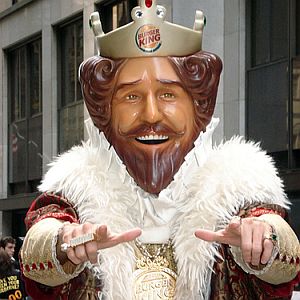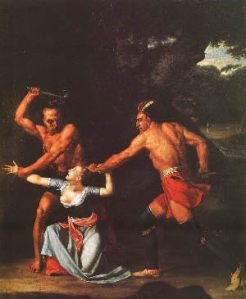 Men at Arms by Terry Pratchett
Men at Arms by Terry Pratchett
When last we left our intrepid Ankh-Morpork Night Watch, things were looking up. This is a nice change from the gutter’s-eye-view we had at the beginning of Guards! Guards!. Things have changed in the time between books. The Watch has a new headquarters, much nicer than its old one, thanks to Lady Sibyl Ramkin, the fiance of Captain Sam Vimes. She comes from an ancient and respectable family, has more money than anyone else in the city, and loves Vimes despite his deep-seated curmudgeonliness, if that is a word.
What’s more, the Watch is taking on new recruits, as ordered by the Patrician. Ankh-Morpork is a city with a very diverse population, and the Patrician believes that the Watch should reflect that diversity. Now we have a Watch open to anyone – trolls, dwarfs, the undead, apes, women – who wants to join, or who doesn’t want to get their heads beaten in. Carrot Ironfoundersson has become a beloved figure in the city – he knows everyone and everyone knows him. All in all, things are looking up.
But there are those who are of a mind that things would be better if only Ankh-Morpork had a king….
This is a recurring theme in the early Watch books – the irrational need for royalty. Although, that’s not entirely accurate. Pratchett is a British writer, of course, and he’s got the Queen to look up to, but she doesn’t have all that much real power. Certain people in Ankh-Morpork are looking for a sovereign – not to wave at them and make a Hogswatch speech, but to actually take over their city. They hope, in their hearts, that a king will solve everything. In that way, this recurring theme is not so much about royalty versus populism, but rather the ability to control one’s own life versus allowing someone else to control it for you. The idea that one has responsibility for one’s own actions and well-being is dominant in the Guards books, no more so than in this one.There is a man named Edward d’Eath, and he has a vision. He is the last of an aristocratic line whose power has declined in this age of guilds and merchants. He looks to the past and sees it as better, brighter than the future. He knows that, if he can just do one little thing, Ankh-Morpork – and he – will be restored to glory. That one little thing, of course, is to put a king on the throne.
Not just any king, of course. The fools who thought to use a dragon to set up a puppet king showed how ineffectual that would be. No, this would only work with a real king, a descendant of the ancient kings of Ankh-Morpork. Find him, put him on the throne, and everything will finally be set straight.
Of course, that doesn’t work out nearly as well as Edward hopes. He steals a mysterious artifact to set his plan in motion – the Gonne. It is a weapon created by one of the most brilliant minds on the Disc, a man kept peacefully imprisoned by Ankh-Morpork’s Patrician. It is a device that should have been destroyed, but was instead put on display so that the Assassins, the bringers of death, could look at it and say “Beware this thing.”Like I said, this book is all about making choices in life. Vimes is engaged to be married to Sybil Ramkin, and thus his days as the Captain of the Watch are numbered. He may be in a better position than he was in the last book – having someone try to kill you is always refreshing, after all – but he knows that the life he’s giving up, with all of its pain and trouble and heartache, is the life that he needs to live.
Corporal Carrot needs to choose how best to serve the city of Ankh-Morpork. He is an excellent policeman, probably the only man on the Disc who could get in the middle of an incipient troll/dwarf race riot and shame them out of killing each other. People do what he says – he is, in his own words, “good at being obeyed.” If he wanted to, he could run the city and the city would be glad to let him do it. But is that the best thing for the city?
The troll Detritus and the dwarf Cuddy both have choices – will they conform to the ancient animosity that stands between their two races, or will they overcome it for the common good?And then there’s the Gonne itself. As a weapon, it is frighteningly powerful – much more so than the standard-issue crossbow – and as a firearm, however primitive, it represents a vast escalation in the way violence is done. What’s more, since this is a fantasy novel, the Gonne has something of a mind of its own. Its wielders hear it talking to them, convincing them that the only thing standing between them and what they want are a few simple deaths – something the Gonne can easily provide. It even uses the old NRA saw verbatim – Gonnes don’t kill people. People kill people.
But people have a choice, perhaps more of a choice than the characters of these books do. The Gonne controls them, the trigger practically pulls itself, and when you’re holding it, you can easily understand how a simple shot, one simple thing, could change the world. For the better, of course – always for the better.
Pratchett’s views on guns and their efficacy aside, it’s a very gripping book. There’s the mystery of it, of course – who has the Gonne, and why are they using it – but it’s also a story about characters and the choices they make for themselves. My absolute favorites in this are Detritus and Cuddy. Trolls and dwarfs have a famous antagonism, stretching back to the ancient battle of Koom Valley (the only battle in the multiverse where both sides ambushed each other) and it would be very easy for them to fall into simple, culturally conditioned roles.
While it may be a cliche to say that they found common ground, learned to look past their own prejudices and learned to respect – nay, to like one another, that’s exactly what they did. It is due to Pratchett’s skill as a writer and as a creator of characters that we come to deeply care for this relationship, investing a lot of hope in it. We know that if Cuddy and Detritus can become friends, then maybe there’s hope for everyone. This emotional investment pays off, and Pratchett reaches deep into our hearts at the end, showing that just because you start with a cliche, it doesn’t mean it can’t have depth.Of course, if you’re not quite as analytical as I am, you can still enjoy it as a good murder mystery. Watching Vimes and company piece together the crime is always fun, because there’s always a twist somewhere that you never saw coming. And Vimes really is one of my favorite Discworld characters – he’s cynical and world-weary, but he still has enough idealism within him to carry him through those times that look like they’re trying to kill him.
All in all, a great book and one that’s highly recommended. The earlier Discworld books are largely stand-alone, so if you’ve never read any of the series before, don’t worry – you can pick this one up and you won’t really miss anything. You may, however, find yourself driving back to the bookstore to get as many other Discworld books as you can. I’m just saying….
—————————————————
“Generally, I meet people before they’re buried. The ones I meet after they’ve been buried tend to be a bit over-excited and disinclined to discuss things.”
– Death, Men at Arms
—————————————————
Terry Pratchett on Wikipedia
Men at Arms on Wikipedia
Men at Arms on Amazon.com
Terry Pratchett’s homepage












































